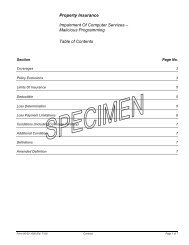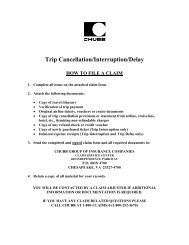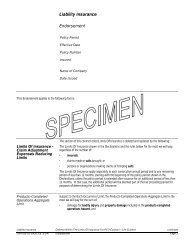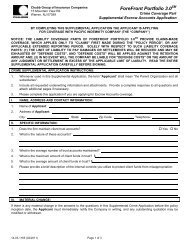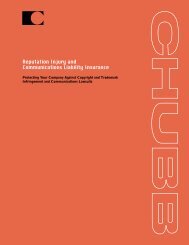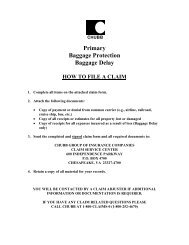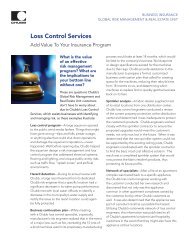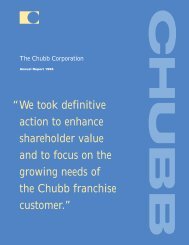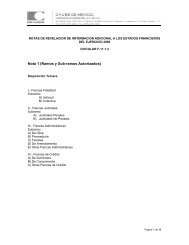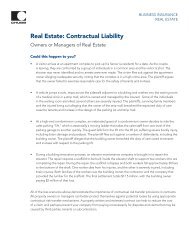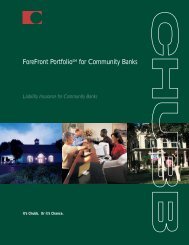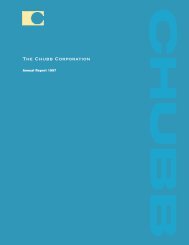Annual Report 2001 - Chubb Group of Insurance Companies
Annual Report 2001 - Chubb Group of Insurance Companies
Annual Report 2001 - Chubb Group of Insurance Companies
You also want an ePaper? Increase the reach of your titles
YUMPU automatically turns print PDFs into web optimized ePapers that Google loves.
(9) Unpaid Claims and Claim Expenses basis. As the Ñnancial resources <strong>of</strong> traditional asbestos<br />
defendants have been depleted, plaintiÅs are targeting<br />
The process <strong>of</strong> establishing loss reserves is complex<br />
these peripheral parties with greater frequency and, in<br />
and imprecise as it reÖects signiÑcant judgmental factors.<br />
many cases, for larger awards. In addition, the plaintiÅs'<br />
This is true because claim settlements to be made in the<br />
bar continues to solicit new claimants through extensive<br />
future will be impacted by changing rates <strong>of</strong> inÖation and<br />
advertising and through asbestos medical screenings. Litiother<br />
economic conditions, changing legislative, judicial<br />
gation is then initiated even though many <strong>of</strong> the claimand<br />
social environments and changes in the property and<br />
ants do not show any signs <strong>of</strong> asbestos-related illness.<br />
casualty insurance subsidiaries' claim handling<br />
Thus, new asbestos claims and new exposures on existing<br />
procedures.<br />
claims have continued unabated despite the fact that<br />
Most <strong>of</strong> the property and casualty insurance subsidiar- usage <strong>of</strong> asbestos has declined since the mid-1970's.<br />
ies' loss reserves relate to long tail liability classes <strong>of</strong> Based on published projections, it is expected that the<br />
business. For many liability claims signiÑcant periods <strong>of</strong> property and casualty insurance subsidiaries will con-<br />
time, ranging up to several years or more, may elapse tinue receiving asbestos claims at the current rate for at<br />
between the occurrence <strong>of</strong> the loss, the reporting <strong>of</strong> the least the next several years.<br />
loss and the settlement <strong>of</strong> the claim. The longer the time<br />
span between the incidence <strong>of</strong> a loss and the settlement Early asbestos claims focused on the major manufac-<br />
<strong>of</strong> the claim, the more the ultimate settlement amount turers, distributors or installers <strong>of</strong> asbestos products<br />
can vary.<br />
under the products liability section <strong>of</strong> primary general<br />
liability policies, which typically had aggregate limits that<br />
Judicial decisions and legislative actions continue to capped an insurer's liability. A growing number <strong>of</strong> asbesbroaden<br />
liability and policy deÑnitions and to increase tos claims by insureds are being presented as<br />
the severity <strong>of</strong> claim payments. As a result <strong>of</strong> this and ""non-products'' claims, such as those by installers <strong>of</strong><br />
other societal and economic developments, the uncer- asbestos products and by property owners who allegedly<br />
tainties inherent in estimating ultimate claim costs on the had asbestos on their property, under the premises or<br />
basis <strong>of</strong> past experience have been exacerbated, further operations section <strong>of</strong> primary general liability policies.<br />
complicating the already complex loss reserving process. Unlike products exposures, these non-products exposures<br />
typically had no aggregate limits, creating poten-<br />
The uncertainties relating to asbestos and toxic waste<br />
claims on insurance policies written many years ago are tially greater exposure. Further, in an eÅort to seek<br />
exacerbated by inconsistent court decisions and judicial additional insurance coverage, some insureds that have<br />
and legislative interpretations <strong>of</strong> coverage that in some substantially eroded their products coverage are present-<br />
cases have tended to erode the clear and express intent <strong>of</strong> ing new asbestos claims as non-products premises or<br />
such policies and in others have expanded theories <strong>of</strong> operations claims or attempting to reclassify old products<br />
liability. The industry as a whole is engaged in extensive claims. The extent to which insureds will be successful in<br />
litigation over these coverage and liability issues and is obtaining coverage on this basis is uncertain.<br />
thus confronted with a continuing uncertainty in its<br />
eÅorts to quantify these exposures.<br />
The expanded focus <strong>of</strong> asbestos litigation beyond as-<br />
bestos manufacturers and distributors to installers and<br />
Asbestos remains the most signiÑcant and diÇcult mass premises owners has created in some instances conÖicts<br />
tort for the insurance industry in terms <strong>of</strong> claims volume among insureds, primary insurers and excess insurers,<br />
and dollar exposure.<br />
primarily involving questions regarding allocation <strong>of</strong> indemnity<br />
and expense costs and exhaustion <strong>of</strong> policy<br />
The property and casualty insurance subsidiaries' most<br />
signiÑcant individual asbestos exposures involve tradition<br />
with the potential for inconsistent results.<br />
limits. These issues are generating costly coverage litiga-<br />
tional defendants who manufactured, distributed or installed<br />
asbestos products for whom excess liability<br />
coverages were written. While these insureds are relaity<br />
<strong>of</strong> the property and casualty insurance subsidiaries<br />
SigniÑcant uncertainty remains as to the ultimate liabil-<br />
tively few in number, such exposure has increased in<br />
recent years due to the increased volume <strong>of</strong> claims, the<br />
related to asbestos related claims due to such factors as<br />
erosion <strong>of</strong> much <strong>of</strong> the underlying limits and the bankdisease<br />
manifestation and the resulting potential for in-<br />
the long latency period between asbestos exposure and<br />
ruptcies <strong>of</strong> target defendants.<br />
volvement <strong>of</strong> multiple policy periods for individual<br />
Other asbestos exposures are mostly peripheral de- claims as well as the increase in the volume <strong>of</strong> claims by<br />
fendants, including a mix <strong>of</strong> manufacturers, distributors plaintiÅs who claim exposure but who have no symptoms<br />
and installers <strong>of</strong> certain products that contain asbestos as <strong>of</strong> asbestos-related disease and an increase in claims Ñled<br />
well as premises owners. Generally, these insureds are under the non-aggregate premises or operations section<br />
named defendants on a regional rather than a nationwide <strong>of</strong> general liability policies.<br />
58



